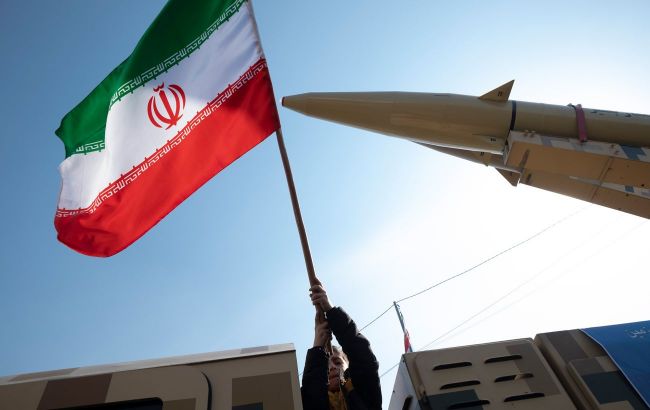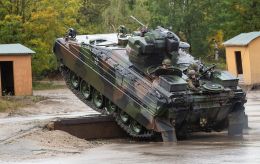Moscow may transfer fighter jets and air defense equipment to Iran - WP
 Photo: Iran may receive fighter jets and air defense equipment from Russia (Getty Images)
Photo: Iran may receive fighter jets and air defense equipment from Russia (Getty Images)
Russia is considering providing Iran with modern fighter jets and air defense equipment to protect it from Israeli and US attacks. Military cooperation between Moscow and Tehran has reached a new level, reports The Washington Post.
According to the data, Iran has opened a new dangerous chapter in its relations with Russia by agreeing to supply thousands of combat drones and missiles in 2022 to help Moscow in its war against Ukraine.
The expanded ties helped cement deals between Moscow and Tehran, including Russia's promise to provide its ally with modern fighter jets and air defense technology that could help Tehran bolster its defenses against any future Israeli or U.S. air strike.
It is unclear how many systems have been delivered and deployed, but the Russian technology could turn Iran into a much more formidable adversary with enhanced capabilities to shoot down aircraft and missiles, officials and experts say.
The arms deals, some of the details of which have not been previously disclosed, are part of broader cooperation that includes joint production of military drones in Russia, sharing of jamming technology, and real-time assessments of weapons deployed against NATO and in Ukraine, intelligence officials and arms experts said. According to them, this cooperation brings significant benefits to both countries, while elevating Iran's status from a junior ally to a strategic partner.
Aircraft and air defense
Intelligence officials said that Russia is pushing forward with secretly concluded deals to supply Iran with Su-35, one of Russia's most powerful fighter-bombers. This potentially threatens the radical modernization of the Iranian air force, which consists largely of refurbished American and Soviet aircraft produced before 1979. Russia has also pledged to provide technical assistance with Iran's spy satellites, as well as help in building rockets to send more satellites into space.
There is no public evidence that the Su-35 has been delivered. According to a US and Middle East intelligence official with knowledge of the deal, the delay may be due to Iran's delay in paying for the aircraft.
On the defense side, Iran has long been asking Russia for the latest anti-aircraft missile batteries to protect its nuclear and military facilities from a possible US or Israeli attack. In 2007, Tehran signed a deal to buy the Russian S-300 anti-aircraft system, but Moscow postponed the delivery of the weapon due to pressure from the United States and European states, the voluntary ban ended in 2016, and Iranian S-300s became operational in 2019.
Since then, Iran has sought to acquire the more powerful Russian S-400 system, although it is not publicly known whether Moscow has taken steps to supply S-400 batteries.
Some S-400 variants are equipped with radars capable of countering stealth technologies used by modern military aircraft. Russia has deployed the S-400 to protect its military bases in Syria, and these batteries pose a potentially lethal threat to US and Israeli warplanes that occasionally operate in Syrian airspace.
An Israeli airstrike on the Iranian consulate in Damascus on April 1 killed two Iranian generals, which directly led to Iran's decision to launch drones and missiles against Israel over the weekend.
Lt. Gen. Herzi Halevi, the Israel Defense Forces chief of staff, said on Monday that Iran's attack "will be met with a response."
If delivered, the new Russian anti-aircraft missiles, deployed to protect underground bases carved into rocky mountains, would certainly make Iranian airspace "a more dangerous place," said Can Kasapoglu, a senior fellow at the Hudson Institute.
Moscow's benefit
According to intelligence officials, Moscow also benefits from this cooperation. In addition to the thousands of drones purchased from Iran, late last year Russia agreed to buy about $2 billion worth of additional military goods, including anti-drone defense systems, which have become a top priority for Russian generals in Ukraine.
Iran has separately agreed to sell Russia surface-to-surface missiles for use against Ukraine and, according to a new intelligence assessment, is expected to begin transferring the weapons soon. According to officials, intelligence agencies have not yet found any evidence that the missiles have been delivered.
Meanwhile, according to intelligence officials, the production of combat drones has become a joint venture between the two countries. Initially, Iran's supply of drones to Russia was an attempt by Tehran to help its ally plug a hole in its military campaign against Ukraine. Russia, which had combat drones at the beginning of the war, began using two types of Iranian-made Shahed drones in the fall of 2022.
By mid-summer 2023, Russia began producing Iranian Shahed-136 drones at a plant in Alabuga, a city in Russia's Tatarstan. Russian documents obtained by The Washington Post last year describe plans to produce 6,000 drones by the summer of 2025 to be used in strikes against Ukrainian forces, as well as power plants and other vital infrastructure.
Concerned about Russia's domestic production, the Ukrainian military launched a drone attack on the Alabuga complex on April 2.
After Russia invaded Ukraine, Moscow received support from Iran and China and continues to trade with them, while Tehran keeps supplying weapons.

